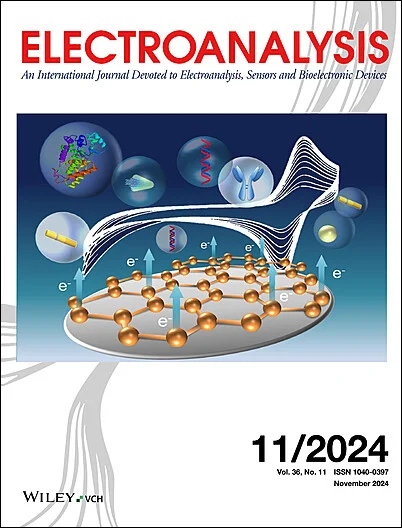用于电化学测定褪黑素的碳纳米管微电极
IF 2.7
3区 化学
Q2 CHEMISTRY, ANALYTICAL
引用次数: 0
摘要
伏安法有望实现褪黑素的快速灵敏定量。本研究报告采用碳纳米管(CNT)纤维横截面作为微电极,对褪黑素进行直接电化学定量。采用六种相同的高致密化 CNT 纤维横截面对 0.05-100 µM 范围内的褪黑激素进行定量。检测限和定量限分别为 10 nM 和 35 nM,灵敏度为 0.1322 nA/µM。尿酸、次黄嘌呤和抗坏血酸的干扰研究证明了它的性能。通过测量食品、药品和人体尿液样本中的褪黑激素,突出了该仪器在实际应用中的优势。本文章由计算机程序翻译,如有差异,请以英文原文为准。

Carbon-Nanotube Microelectrodes for Electrochemical Determination of Melatonin
Voltammetric methods hold promise for the rapid and sensitive quantification of melatonin. This study reports the direct electrochemical quantification of melatonin using carbon nanotube (CNT) fiber cross-sections as microelectrodes. Six identical highly densified CNT fiber cross-sections were employed to quantify melatonin in the range of 0.05–100 μM. The limit of detection and quantification were 10 and 35 nM, respectively, with a sensitivity of 0.1322 nA/μM. Interference studies with uric acid, hypoxanthine, and ascorbic acid demonstrate its performance. Real-world application was highlighted by measuring melatonin in food, pharmaceutical, and human urine samples.
求助全文
通过发布文献求助,成功后即可免费获取论文全文。
去求助
来源期刊

Electroanalysis
化学-电化学
CiteScore
6.00
自引率
3.30%
发文量
222
审稿时长
2.4 months
期刊介绍:
Electroanalysis is an international, peer-reviewed journal covering all branches of electroanalytical chemistry, including both fundamental and application papers as well as reviews dealing with new electrochemical sensors and biosensors, nanobioelectronics devices, analytical voltammetry, potentiometry, new electrochemical detection schemes based on novel nanomaterials, fuel cells and biofuel cells, and important practical applications.
Serving as a vital communication link between the research labs and the field, Electroanalysis helps you to quickly adapt the latest innovations into practical clinical, environmental, food analysis, industrial and energy-related applications. Electroanalysis provides the most comprehensive coverage of the field and is the number one source for information on electroanalytical chemistry, electrochemical sensors and biosensors and fuel/biofuel cells.
 求助内容:
求助内容: 应助结果提醒方式:
应助结果提醒方式:


